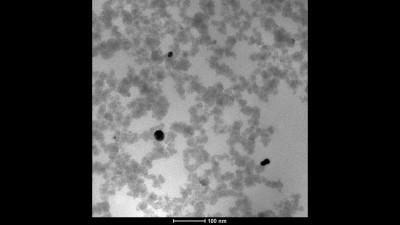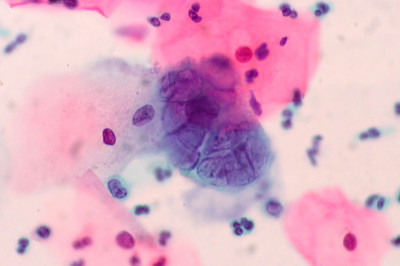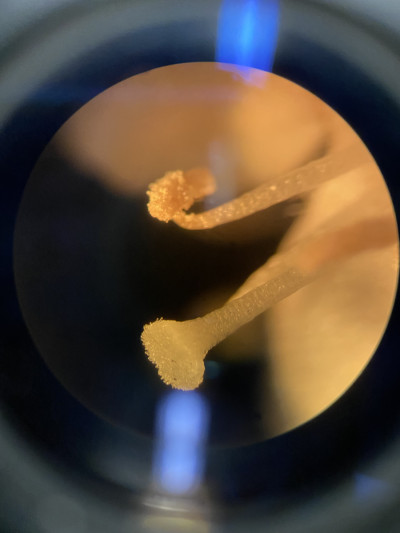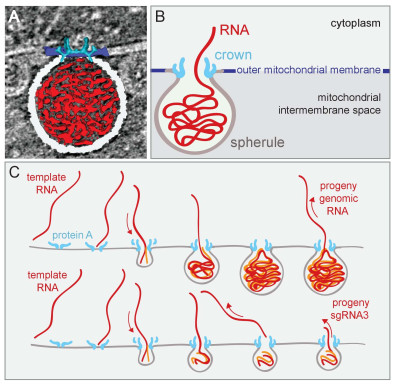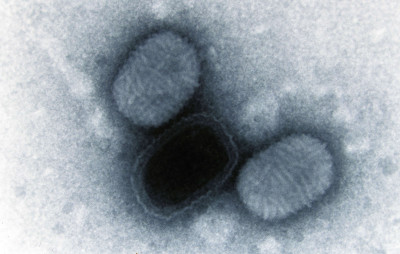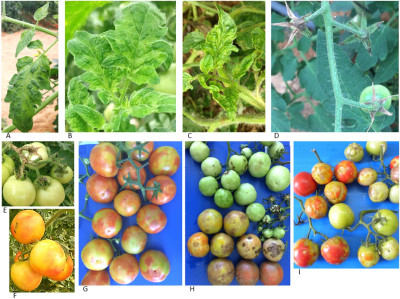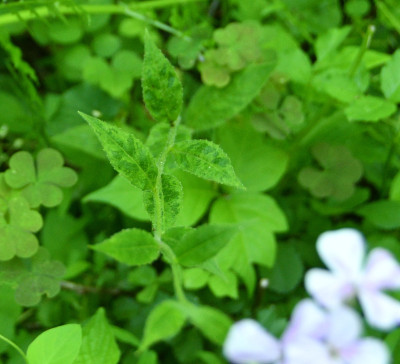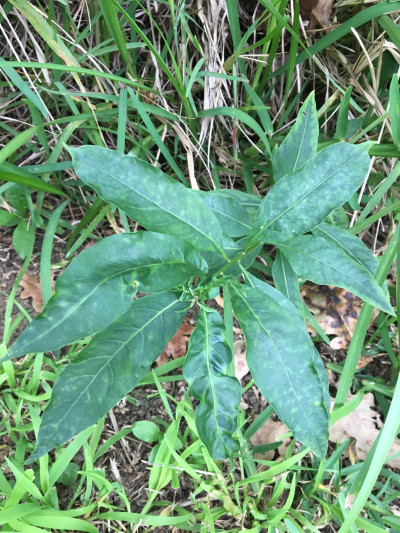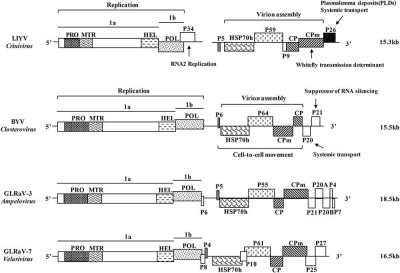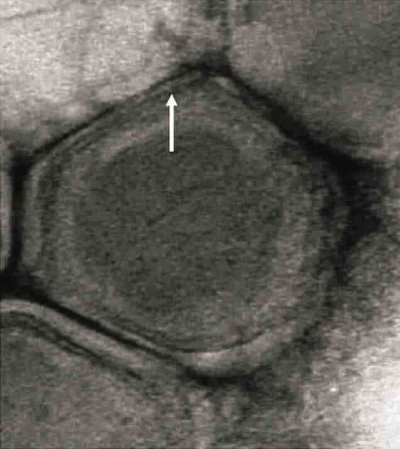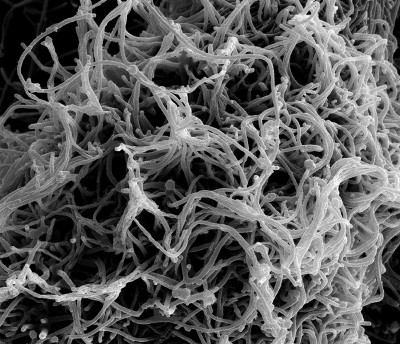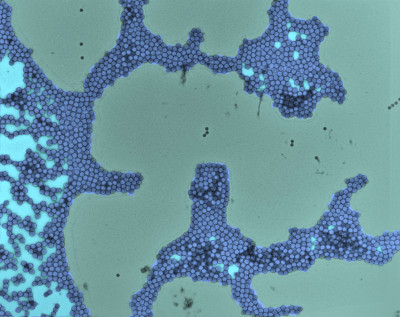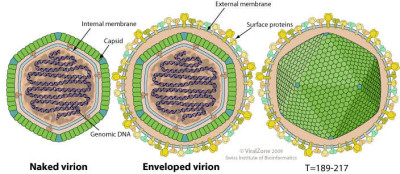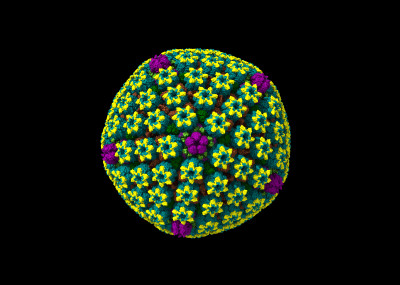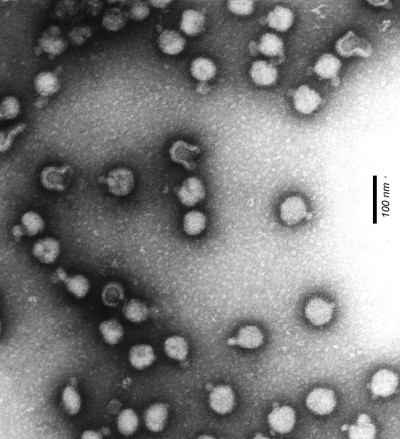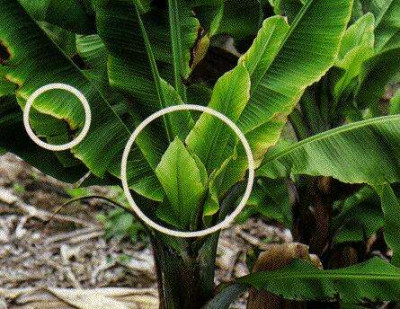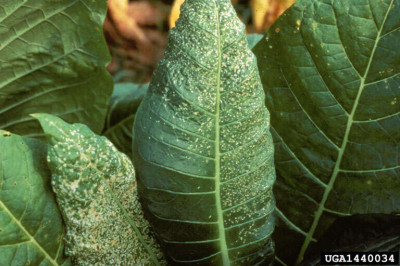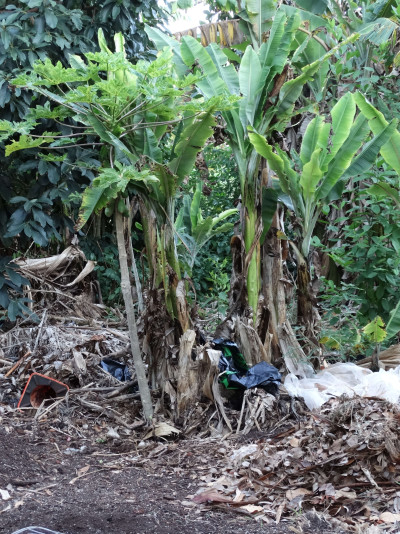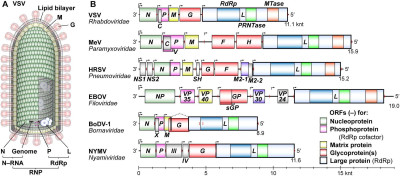Brittle solids can be reduced up to a nanometric size by simple dry grinding (top-down approach). For example, elemental tellurium is a very brittle and easily pulverized metalloid, that has been dry grinded in a Mixer Mill Retsch MM-200 apparatus (7h at a frequency of 25Hz) to generate a hyperfine tellurium powder [1][2][3].
04 Feb 2024
Herpesvirus infection on ThinPrep Pap. Pathological and histological images courtesy of Ed Uthman at flickr.
Ed Uthman, Wikimedia Commons
22 Feb 2024
Highlighted in the image is a 400X view of ripe androecium and receptive gynoecium ready for pollination under a compound microscope.
11 Mar 2024
Model of Flock house nodavirus (FHV) replication complex structure and function. (A) Amira-assisted 3D segmentation of a single virus replication compartment in FHV-infected cells. The spherule membrane (white) encloses the viral RNA (red) and is anchored to the mitochondrial outer membrane (dark blue), by the FHV protein A crown (light blue, derived from the subtomogram average). (B) Cartoon rendering of the image in (A). Viral RNA is shown as exiting the spherule to include the observation of fibrillary extrusions in many other tomograms. (C) Model of the FHV RNA complex and RNA synthesis, where positive-strand RNA (red) associates with protein A on the mitochondrial membrane to initiate the synthesis of negative-strand RNA (orange) and progeny positive-strand RNA accommodated by increasing volume of the spherule as if blowing up a balloon. In this model, subgenomic RNA3 results from attenuated negative strand synthesis and subse- quent positive-strand production in small spherules. [1]
Kenneth J Ertel, Desirée Benefield, Daniel Castaño-Diez, Janice G Pennington, Mark Horswill, Johan A den Boon, Marisa S Otegui, and Paul Ahlquist
11 Mar 2024
Negatively stained transmission electron micrograph of molluscum contagiosum viruses from the vesicle fluid of an infected human. The viruses were not purified or concentrated.
Wikimedia Commons, Graham Beards
14 Mar 2024
Naturally infected tomato plants. (A-C) Symptomatic mosaic pattern on leaves of cluster tomato plants cv. Mose. (C) Narrowing leaves of cluster tomato plants. (D) Dried peduncles and calyces on cherry tomato plants cv. Shiran leading to fruit abscission. (E) Necrotic symptoms on pedicle, calyces and petioles cv. Ikram. (F) Typical fruit symptoms with yellow spots cv. Mose. (G-I) Variable symptoms of tomato fruits cv. Odelia. (G) The typical disease symptoms. (H) Symptoms of mixed infections by the abundant TSWV and the new tobamovirus isolate. (I) Unique symptoms of the new tobamovirus isolate found at a single location at Sde-Nitzan village.[1]
Luria N, Smith E, Reingold V, Bekelman I, Lapidot M, Levin I, et al., Wikimedia Commons
14 Mar 2024
Turnip mosaic virus (TuMV) is a plant pathogenic virus that infects a wide range of plant species, particularly those in the family Brassicaceae, which includes cruciferous vegetables like turnips, cabbage, and mustard. Belonging to the genus Potyvirus within the family Potyviridae, Turnip mosaic virus is one of the most economically significant viruses affecting cruciferous crops worldwide.
iNaturalist
25 Apr 2024
Cestrum Yellow Leaf Curling Virus (CmYLCV) is a plant virus that primarily infects Cestrum species, which are ornamental plants known for their fragrant flowers. Although it is not as widely known as some other plant viruses, CmYLCV can cause significant damage to infected plants, leading to symptoms that affect both the aesthetic and health value of the plants.
iNaturalist
23 May 2024
Schematic diagrams of the genome structure of the representative viruses in the four genera of the family Closteroviridae. LIYV, Lettuce infectious yellows virus, genus Crinivirus; BYV, Beet yellows virus, genus Closterovirus; GLRaV-3, Grapevine leafroll-associated virus 3, genus Ampelovirus; GLRaV-7, Grapevine leafroll-associated virus 7, genus Velarivirus. ORFs are shown as boxes, with the related domains indicated in the same in-fill. PRO, papain-like cysteine proteinase; MTR, methyltransferase; HEL, helicase; POL, RNA-dependent RNA polymerase; HSP70h, heat shock protein 70 homolog; CP, capsid protein; CPm, minor capsid protein; P, proteins named by their approximate molecular mass (e.g., P34, 34-kDa protein). The functional roles of some of the protein products are indicated with the well-studied LIYV and BYV. Genome size is labeled on the right side.[1]
Wikimedia Commons, Wenjie Qiao, Vicente Medina, and Bryce W. Falk
01 Apr 2024
Emiliania huxleyi virus 86 (EhV-86) virion showing the putative internal lipid membrane (arrowed).
Wikimedia Commons, Wilson, W.H., Van Etten, J.L., Schroeder, D.C., Nagasaki, K., Brussaard, C., Bratbak, G. and Suttle, C.; Mackinder et al.
24 Jan 2024
Scanning electron micrograph of filamentous Ebola virus particles budding from an infected VERO E6 cell (35,000x magnification).
NIAID, Wikimedia Commons
24 Jan 2024
Great strength and ability of the virus to multiply very large scale. An adenovirus population (observed by electron microscopy) can then form a set resembling a mosaic.
Wikimedia Commons, Roingeard
02 Feb 2024
Schematic drawing of a virion of the subfamily Alphairidovirinae, family Iridoviridae, cross section without and with envelope, as well as side view. Polyhedral virions 120-350 nm in diameter. The capsid displays an icosahedral symmetry T=189-217, with an internal lipid membrane. Virions are either externally enveloped or not depending whether they budded from the cell membrane, or were arranged in paracrystaline array in the host cell cytoplasm and were released by lysis.
ViralZone, SIB Swiss Institute of Bioinformatics, Wikimedia Commons
22 Feb 2024
Herpes simplex virus Capsid visualized with ChimeraX.
Victor Padilla-Sanchez, Wikimedia Commons
22 Feb 2024
Schematic drawing of a virion of the family Rudiviridae. Non-enveloped, rod-shaped, rigid, with three tail fibers at either end.
ViralZone, SIB Swiss Institute of Bioinformatics, Wikimedia Commons
23 Feb 2024
Semliki forest virus from purified cellculture supernatant after gel-filtration and ultracentrifugation, magnification 90,000x, ELMI C10 Zeiss.
Wikimedia Commons, Gleiberg
01 Mar 2024
The Banana Bunchy Top Virus (BBTV), a serious disease of bananas, was discovered on Oahu in 1989 on a farm at Punaluu. It is now found in most areas of Oahu. It has spread to the islands of Hawaii and Kauai. BBTV causes the stunting of the leaves resulting in a "bunched" appearance. Generally, a banana plant infected with the virus will not set fruit. Other symptoms include stunted keikis or young shoots, narrow, yellow, and brittle leaves, and dark green streaks on the leaf stalks. Although the neighbor islands are free of the virus, BBTV poses a serious threat to the State's banana industry.
State of Hawaii, Wikimedia Commons
11 Mar 2024
Symptoms of tobacco etch virus (TEV) (Potyvirus TEV) Description: The first symptom of TEV infection is a pronounced vein clearing on expanding leaves. This is followed by necrosis of a thin line of tissue along the veins, resulting in an etched pattern. Subsequently, young leaves develop a mosaic which fades to mottling as the leaf ages. Etching and more pronounced veinal necrosis is common. Plant growth is retarded, resulting in stunting, especially when young plants are infected. The virus overwinters in perennial solanaceous weeds and is transmitted to tobacco by migrating aphids. TEV often occurs in combination with other aphid-borne viruses. Tobacco etch is one of the most common virus diseases of burley.
Wikimedia Commons, R.J. Reynolds Tobacco Company
14 Mar 2024
Banana bunchy top virus (BBTV) The papaya plant in this image is infected with papaya ringspot virus (PRSV), as evidenced by the foliar mosaic.
Wikimedia Commons, Scot Nelson
01 Apr 2024
Schematic diagrams of a vesicular stomatitis virus (VSV) virion and Non-segmented negative strand (NNS) RNA viral genomes. (A) A VSV particle is composed of a cellular lipid bilayer, viral RNA genome, and five viral proteins: nucleo- (N), phospho- (P), matrix (M), glyco- (G), and large (L) proteins. The virus particle contains a ribonucleoprotein (RNP) composed of N–RNA and RNA-dependent RNA polymerase (RdRp) complexes. (B) The gene organization of negative-strand genomes of typical NNS RNA viruses [measles virus (MeV), human respiratory syncytial virus (HRSV), Ebola virus (EBOV), Borna disease virus 1 (BoDV-1), and Nyamanini virus (NYMV)] belonging to different families is depicted in the 3′ to 5′ order. Transcription initiation and termination sites are shown by bent arrows and red vertical lines, respectively. The positions of negative-strand open reading frames are shown by colored boxes. The L genes encode an L protein with RdRp, GDP polyribonucleotidyltransferase (PRNTase), and methyltransferase (MTase, except for nuclear-replicating viruses) domains. A scale bar is shown at the bottom (knt, kilo nucleotides).[1]
Wikimedia Commons, Tomoaki Ogino and Todd J. Green
02 Apr 2024
 Encyclopedia
Encyclopedia
